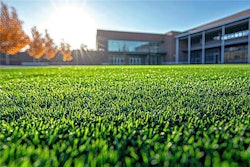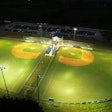Removal and prevention of puddles can ensure your ball diamonds stay playable in all but the most severe weather.
There's no greater visual evidence that a baseball or softball game should be delayed, postponed or canceled than standing water on the infield. Removal and prevention of puddles can ensure your ball diamonds stay playable in all but the most severe weather.
Remove as much water from the infield depression as possible using a hand pump, sponge-like pillows or large sections of foam rubber, which can be wrung out over grass and reused.
Drill holes through the infield profile to allow water to move vertically.
Once the water has dissipated, rake the muddy infield material, allowing more surface area to come in contact with surrounding air.
If necessary, amend the infield soil with calcined clay, a kiln-fired material that is porous and absorbent.
Once the area has firmed up sufficiently, finish it using standard pregame procedures.
Prevent future puddles by introducing a leveling bar to the dragging regimen every two weeks or so to knock down ridges, as well as fill in depressions at the slide zones near second and third base and at the defensive positions of the shortstop and second baseman.
Varying drag directions and patterns (from circles to figure eights, for example) on a day-to-day basis will prevent excess material from accumulating in one area at the expense of others. The same goes for varying the location of where a drag mat is set down and picked up. Both techniques will help ensure that an infield remains as level as possible.





































